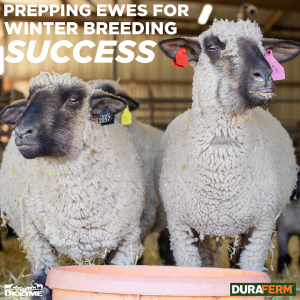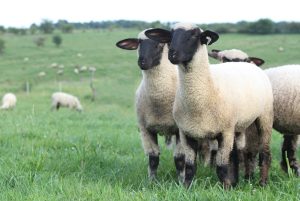
Have you ever experienced the sound of a newborn lamb crying for its mom? Have you seen those long, spindly legs attempting to take their first steps, standing to suckle their mother’s milk? The smell of wool, straw and newborn lambs is a scent that will stick in your mind for a lifetime if you let it. Lambing season is one of my favorite childhood memories.
Today, our DuraFerm® team is still living out the thrill of lambing season – raising their own flocks of sheep in various parts of the country. But when is lambing season? That’s a question we get asked often. Here’s our answer. It depends.
Really, When is Lambing Season?
Lambing takes place, on average, 145 days after the ewe is bred. Sheep gestation is the length of time the lamb grows and develops within the womb.
Biologically, ewes are cool season breeders. Since their gestation lasts about 5 months, traditionally producers would breed them in the fall, meaning lambs would be born in late winter to early spring.
However, the lambing season has moved. The shift in the seasonality of lambing from a traditional spring/winter pattern to year-round lambing is a result of multiple factors. But, specifically, demand and advanced reproductive technologies have changed how the industry approaches breeding.
As a result, now more than ever, answers to “when is lambing season” may vary. The region of the country you live in, who your customer base is and what kind of facilities you lamb in will dictate your answer.
If you want to calculate when your lambing season will start based on your own breeding season, check out our interactive sheep gestation calculator.
4 Reasons Lambing Season Have Shifted
1. Reproductive Management & Controlled Breeding Techniques
Selective Breeding
Advances in breeding techniques have allowed producers to select breeds and genetics of sheep that are less tied to natural seasonal cycles. Traditionally, ewes (female sheep) have a natural reproductive cycle that leads them to lamb in the spring, when temperatures are warmer and feed is more abundant.
Hormone Treatments
Hormonal interventions, such as the use of progesterone and other treatments, can manipulate the estrus, or heat, cycles of ewes. This allows them to breed at any time of the year. This gives sheep producers more control breeding and lambing times.
Artificial Insemination (AI)
Sheep AI has made it easier for sheep breeders to schedule lambing year-round by controlling when ewes are bred.
2. Indoor Lambing & Environmental Control
Indoor Lambing Systems
Traditionally, lambing was tied to spring because outdoor conditions were harsh in winter, and spring provided the best natural conditions for lamb survival and growth. Modern operations, especially in more advanced systems, often house ewes indoors, providing controlled environments that protect ewes and lambs from the elements. This allows lambing to occur year-round without the risks associated with outdoor weather.
Feeding Strategies
Indoor systems enable more consistent feed availability and quality throughout the year, reducing reliance on seasonal pasture growth. Producers can provide high-quality feed or silage to ewes, ensuring they have the nutrients needed for lambing at any time of the year.
3. Consumer & Customer Demand
Constant Market Supply
With the rise of supermarkets and global markets, there is a growing consumer demand for lamb year-round. In response, producers have adopted breeding systems that enable more consistent production and lambing cycles to ensure a steady supply of lamb meat throughout the year.
This shift has been particularly important in meeting demand during non-traditional lambing seasons, such as Christmas or Easter in the Northern Hemisphere, where lamb consumption spikes.
Show Lamb Markets
Many sheep producers have started raising lambs for a show lamb customer base. Exhibitors now have the ability to show lambs year-round at various county fairs, jackpots and national shows. It is important for breeders to be able to provide elite show lamb prospects to their customers when they need them.
4. Intensive Farming Practices
Some producers have adopted intensive lambing systems, such as three lambings in two years or even more frequent schedules. The move from seasonal lambing to year-round lambing is largely due to advancements in reproductive technology, improved management practices and the need to meet continuous customer demand.
These systems take advantage of controlled breeding and housing conditions to increase productivity. Breeds that are more prolific or have a shorter gestation cycle can be used to achieve this.
DuraFerm Can Help
We might have waffled with our “it depends” answer to “when is lambing season.” However, one thing we are sure about is how vitally important nutrition is leading up to the lambing process. DuraFerm is a renowned brand of nutritional supplements for sheep and goats. Our products support optimal digestion and nutrition for maximized performance at every stage of production.
Best of all, DuraFerm products use the latest technology and organic trace minerals to improve reproductive success in sheep and goats. If you’re looking to take your operation to the next level, DuraFerm has your back.
The DuraFerm brand is developed by BioZyme®, a fermentation company pioneering advancements in animal nutrition and health. Through innovative research and high-quality manufacturing, BioZyme creates powerful solutions that improve animal performance and support producer profitability in the agricultural industry.
Our mission: undeniable positive impact on the health and wellness of your animals and your operation.
Get your DuraFerm Today
Now that we’ve explored “when is lambing season,” we are ready to help provide you with a quality nutritional supplement for your flock.
You can purchase DuraFerm products powered by AO-Biotics® Amaferm®. DuraFerm is available through the extensive BioZyme dealer network. Locate a dealer near you today. DuraFerm offers reproduction resilience and retention. What more could you ask for?
You can also gather more information about DuraFerm from our educational blog series or by signing up for our newsletter.

